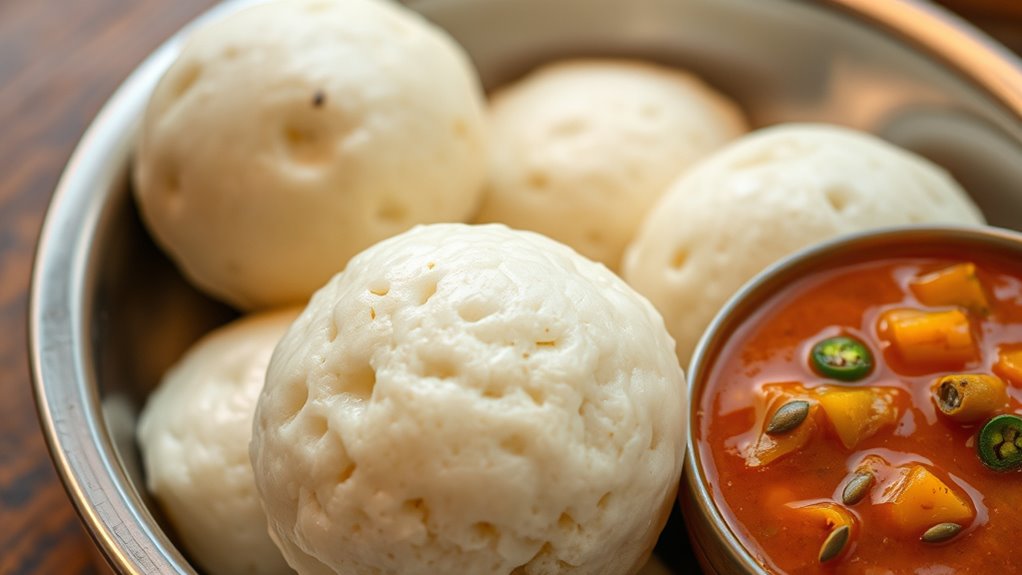To perfect your South Indian idli and sambar pairing, select soft, well-fermented idlis that suit your texture preference, and choose sambar styles that match your spice tolerance—mild, medium, or spicy. Add flavorful sides like coconut chutney or vada to enhance textures, and serve both warm at ideal temperatures for best flavor. Pay attention to spice balancing and garnishes to elevate your meal. If you keep exploring, you’ll discover even more ways to create an authentic, satisfying experience.
Key Takeaways
- Choose soft, well-fermented idlis and serve them warm at 45-50°C for optimal texture and flavor.
- Adjust sambar spice levels using chili, tamarind, and coconut milk to suit your preferred heat.
- Pair idlis with complementary sides like coconut chutney, sambar, and crunchy vadas for enhanced taste.
- Dip idlis gently into warm sambar, adding extra for flavor, and garnish with cilantro or lime for freshness.
- Maintain proper serving temperatures and food safety to ensure the best dining experience.
Choosing the Perfect Idli for Pairing
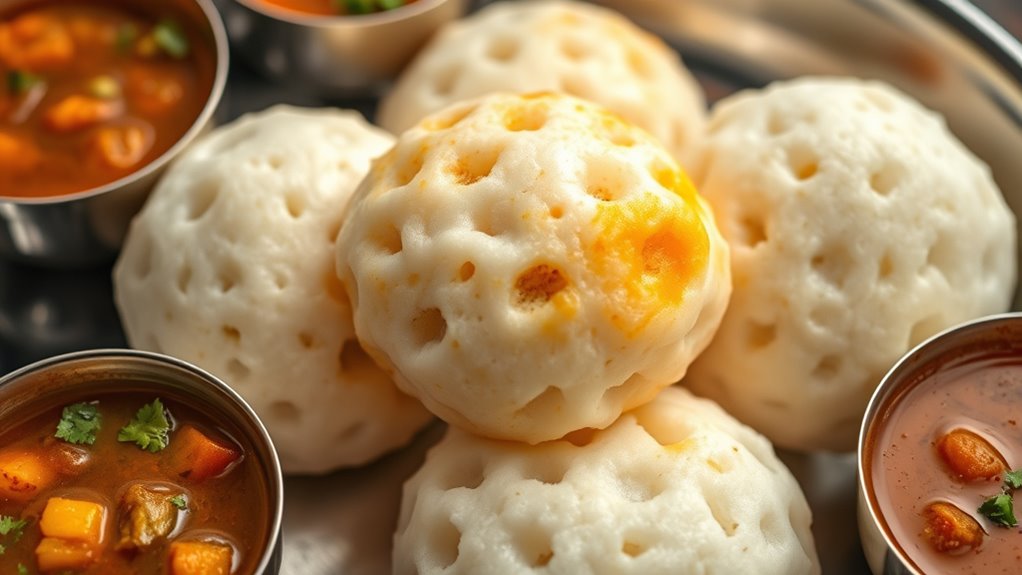
Choosing the perfect idli for pairing begins with understanding the different textures and flavors available. You’ll find soft, fluffy idlis that melt in your mouth, or slightly firmer ones with a more substantial bite. Some idlis are lightly fermented, offering a tangy flavor, while others are milder and neutral. If you prefer a delicate texture, opt for traditional steamed idlis made from fermented rice and urad dal. For a heartier option, millet or ragi idlis provide extra nutrition and a different flavor profile. Consider the consistency you enjoy—whether airy and light or dense and chewy. Matching these textures and flavors to your sambar choice enhances your meal, making each bite more satisfying. Knowing your preferences helps you select an idli that complements your sambar perfectly. Additionally, selecting well-fermented idlis can improve both flavor and digestibility, ensuring a more enjoyable meal.
Understanding Sambar Variations and Their Flavors
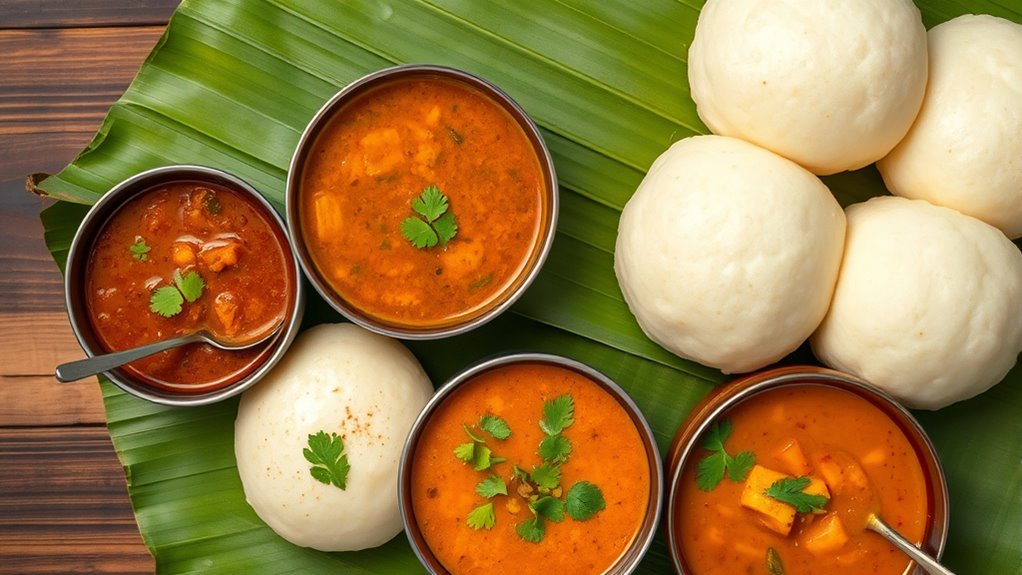
Sambar comes in a variety of styles and flavor profiles, each crafted to suit different tastes and regional preferences. Some are thick and hearty, while others are light and tangy. The ingredients and spice blends vary, influencing the overall flavor experience. For instance, Tamil sambar often features coconut, while Andhra sambar leans toward spiciness. Understanding regional ingredients can significantly influence the flavor, making each variation unique to its area. Understanding these differences helps you select the right sambar to complement your idli. Here’s a quick overview:
| Style | Key Ingredients | Flavor Profile |
|---|---|---|
| Tamil | Coconut, roasted spices | Mild, creamy |
| Andhra | Tamarind, red chili | Spicy, tangy |
| Karnataka | Coconut, coriander seeds | Aromatic, medium heat |
| Kerala | Curry leaves, coconut | Mild, rich |
Balancing Spice Levels for Every Palate
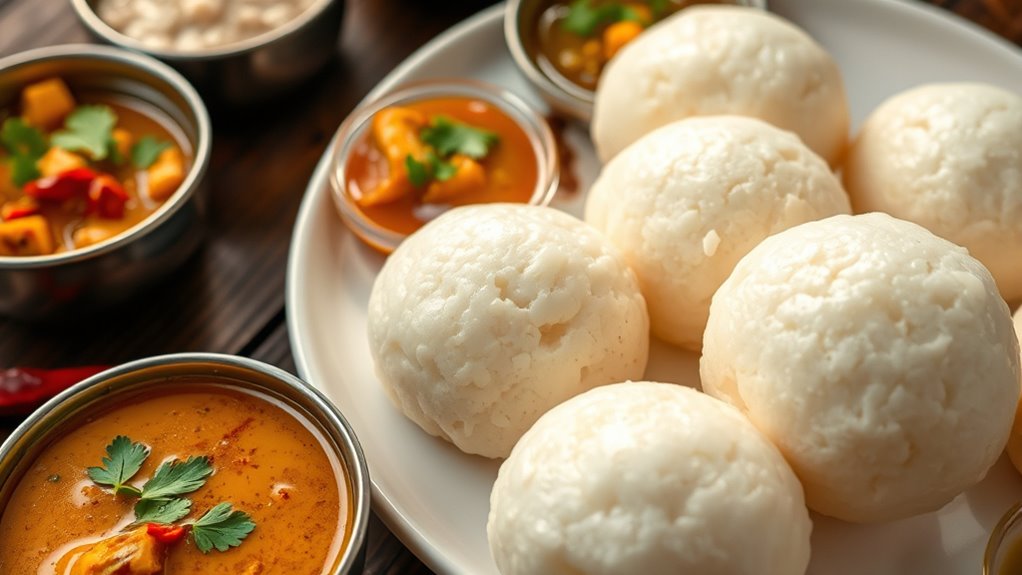
Finding the right spice level can transform your idli and sambar pairing into a perfect harmony of flavors. To achieve this, start by evaluating your taste preferences—whether you prefer mild, medium, or spicy. If your sambar is too hot, add a splash of coconut milk or a squeeze of lemon to tone down the heat without losing flavor. Conversely, if it’s too mild, incorporate more chili powder or fresh green chilies gradually. Remember, balance is key; a little spice can enhance the dish without overwhelming it. Taste as you go to ensure the heat complements the savory richness of the sambar and the soft, neutral flavor of the idli. Adjusting spice levels allows everyone to enjoy the meal to their liking. Incorporating grocery savings strategies can also help you experiment with different spice intensities affordably. Additionally, using quality spices can make a significant difference in achieving the desired flavor profile.
Enhancing Textures With Complementary Sides
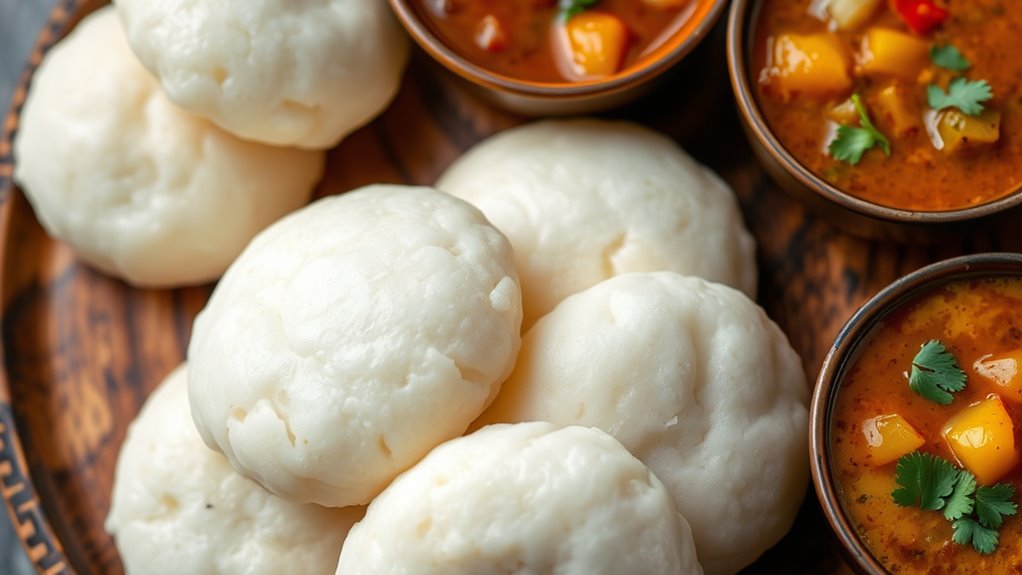
Adding the right complementary sides can remarkably enhance the textures of your idli and sambar meal, making each bite more satisfying. To create a delightful contrast, consider these options:
Enhance your idli and sambar with crispy vada, tangy chutney, and sweet banana chips for a delightful contrast.
- Crispy Vada – adds crunch and a hearty bite that balances soft idli.
- Tangy Coconut Chutney – offers a smooth, creamy texture that complements the fluffy idli.
- Fried Banana Chips – bring a crispy sweetness that pairs well with the savory flavors.
- Including texture contrast in your meal enhances the overall dining experience and keeps your palate engaged.
- Incorporating textural variety by selecting sides with different consistencies can elevate the meal and introduce new flavor dimensions.
Choosing sides with varied textures elevates the overall experience, making each mouthful more interesting. Play with different combinations to find what suits your palate best. Remember, contrasting textures can turn a simple meal into a memorable feast, enriching every bite with layers of flavor and consistency.
Serving Temperature Tips for Optimal Enjoyment
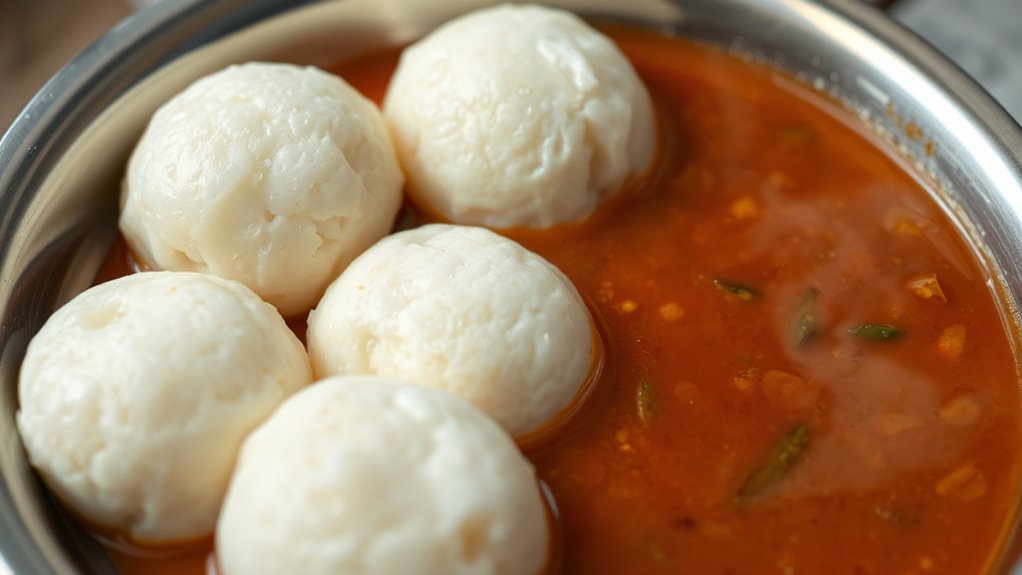
To enjoy idli and sambar at their best, you need to pay attention to serving temperature. Serving them warm enhances flavor and texture, but freshness also matters—hot or room temperature can make a big difference. Consider whether you prefer the comfort of warm or the simplicity of room temp for your perfect meal. Incorporating the right serving practices can also help improve overall texture and appearance of your skin, much like selecting the optimal serving temperature enhances the enjoyment of your meal. Research indicates sound waves can influence brainwave patterns, which could help you synchronize your mood and expectations for a more satisfying experience. Recognizing angel number patterns can also help you align your mood and expectations for a more satisfying experience.
Ideal Serving Temperature
Serving your idli and sambar at the right temperature greatly enhances their flavors and texture. For maximum enjoyment, aim to serve them warm but not hot. When the idli is too cold, it becomes dense and less flavorful; too hot, and it loses its softness. Similarly, sambar should be warm enough to release its aroma without becoming scalding. To achieve this:
- Reheat the idli gently in a steamer or microwave until just warm.
- Warm the sambar to a temperature where steam rises but it doesn’t boil vigorously.
- Serve immediately after warming to preserve the ideal texture and aroma.
Following these tips ensures your meal remains tender, flavorful, and satisfying from the first bite to the last.
Temperature for Freshness
Maintaining the right temperature when serving idli and sambar is essential to preserve their freshness and ideal flavors. Serve idlis warm or slightly chilled—around 45-50°C—to keep their soft texture and prevent them from drying out. Sambar should be hot, ideally between 60-70°C, to enhance its aroma and spice balance. If you serve sambar too cold, it dulls the flavors and can make the dish less appetizing. Conversely, too hot sambar may overpower the delicate idlis. Keep both dishes covered until serving to retain their temperature. Using a pre-warmed plate or bowl helps maintain freshness longer. Proper temperature control ensures each bite remains flavorful, soft, and satisfying, elevating your overall dining experience. As the Best Vacuums for Dust Removal in 2024 highlight, maintaining cleanliness and freshness is key to a pleasant meal.
Warm vs. Room Temp
Choosing the right serving temperature can make a noticeable difference in how you enjoy idli and sambar. Serving them warm enhances their flavors and creates a comforting experience, while room temperature can preserve their subtle textures. To optimize your meal, consider these tips:
- Warm the idli slightly before eating—microwave for 15-20 seconds—to boost softness.
- Serve sambar warm but not boiling—around 110°F (43°C)—to release its rich aroma.
- If you prefer room temperature, guarantee the sambar isn’t too cold, which can dull its spices and taste.
- Monitoring serving temperature is essential for maintaining the optimal flavor profile of both dishes.
- Proper temperature control can also prevent spoilage and ensure food safety during serving and storage.
- Maintaining consistent temperature throughout the serving process helps preserve the desired textures and aromas.
- Adjusting serving temperature can also influence the texture and aroma of both dishes, enhancing your overall dining experience.
- Paying attention to food safety guidelines ensures that both dishes remain fresh and safe to eat during serving.
Balancing the temperature helps bring out the best in both. Experiment to find what feels most satisfying—warm for comfort, room temp for a more delicate flavor profile.
Incorporating Fresh Herbs and Garnishes
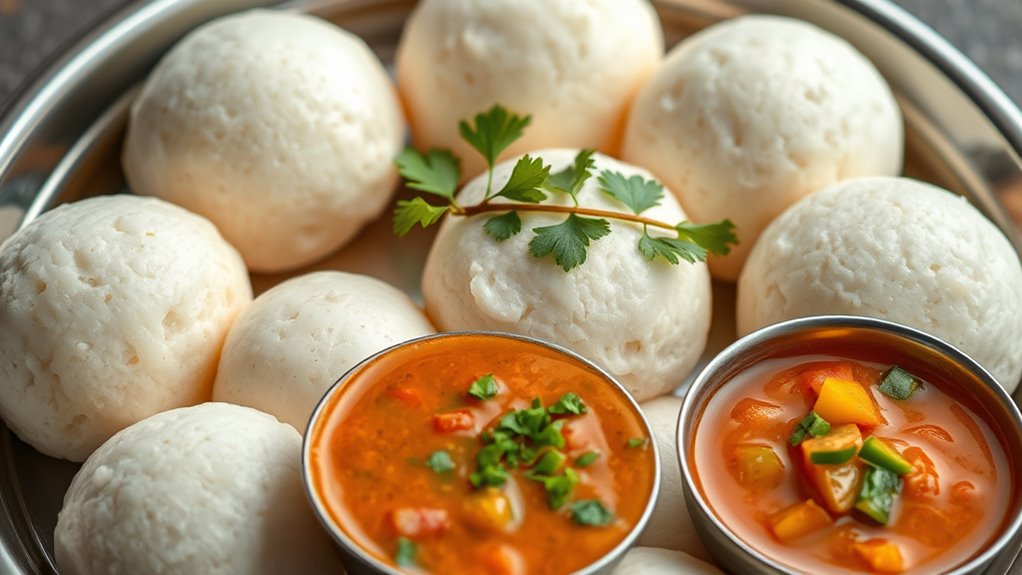
Adding fresh herbs and garnishes can elevate the flavor of your idli and sambar, making each bite more vibrant and aromatic. Chopped cilantro adds a burst of vivacity, balancing the spice and acidity in the sambar. Mint leaves bring a cool, invigorating note that complements the warm, savory flavors. You can also sprinkle a little grated coconut for added texture and subtle sweetness. For a spicy kick, top your dish with finely chopped green chilies or a dash of red chili powder. Lime wedges or lemon juice can brighten the overall taste, enhancing both the idli and sambar. Use garnishes sparingly to avoid overwhelming the delicate flavors, but enough to add visual appeal and an extra layer of freshness to each serving. Incorporating fresh herbs can also provide additional health benefits and enhance the overall nutritional profile of your meal. Including nutritional benefits of herbs can encourage healthier choices and add value to your dish.
Best Dipping Techniques for Idli and Sambar
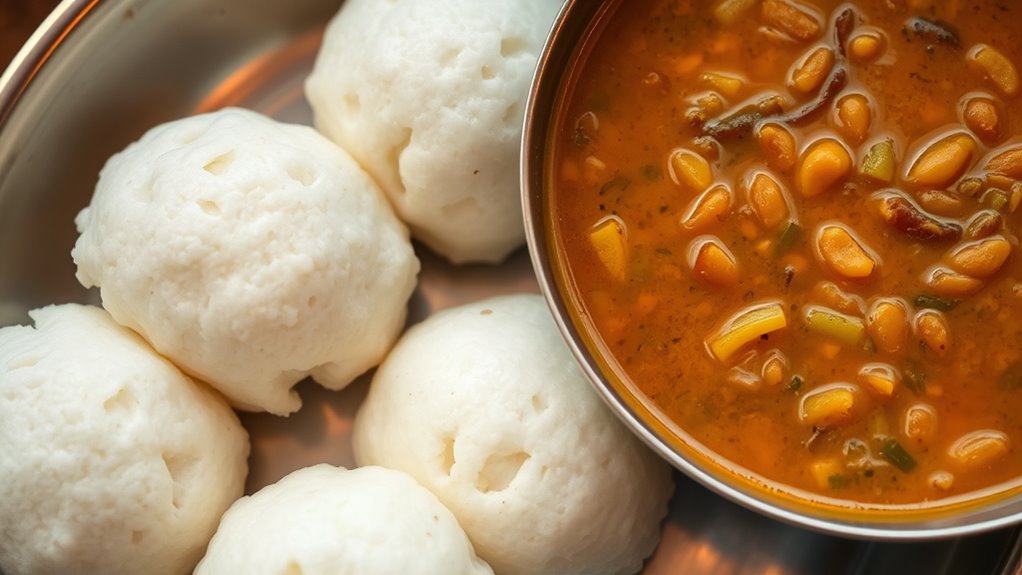
To truly enjoy the flavors of idli and sambar, mastering the art of dipping is essential. First, break the idli into smaller pieces to maximize surface area, allowing for better absorption. Second, dip the idli gently into the sambar, avoiding vigorous movements that can break it apart. Third, hold the idli in the sambar for 2-3 seconds to let it soak up the flavors without becoming mushy. Use a spoon to scoop extra sambar over the pieces for added taste. Make sure your sambar is at the right temperature—warm but not boiling—to enhance flavor absorption. Practicing these techniques keeps the idli intact and ensures each bite is bursting with sambar goodness. Additionally, choosing the right size and shape of idli can improve how well it absorbs the flavors. For an optimal experience, consider the kitchen tools used for dipping, which can influence the ease and effectiveness of the process.
Pairing Sides and Condiments to Elevate the Meal

Enhancing your idli and sambar experience involves more than just perfecting dipping techniques; the right sides and condiments can considerably elevate the meal. To add variety, serve coconut chutney, which offers a fresh, creamy contrast, or spicy tomato chutney for a tangy kick. If you want to boost flavor, try sambar powder or a sprinkle of chopped green chilies. Adding a dash of ghee on hot idlis can enrich their texture and aroma. Pickles, like lemon or mango, provide a burst of acidity that complements the mildness of idli and sambar. Fresh coriander or curry leaves sprinkled on top add a herbal freshness. Using quality ingredients ensures a better overall experience, as high-quality materials can significantly influence the flavor and texture. Incorporating tuning modifications like adding a tadka of mustard seeds and cumin can further enhance the taste of sambar. By thoughtfully pairing these sides and condiments, you enhance the flavors and make each bite more satisfying.
Frequently Asked Questions
How Can I Make My Idli Fluffier for Better Pairing?
To make your idli fluffier, guarantee you soak the rice and urad dal separately for at least 4-6 hours. Use fresh ingredients and blend them smoothly, then let the batter ferment until it doubles in size. Gently fold the batter to incorporate air, avoiding overmixing. Steaming at the right temperature helps, so don’t open the lid too soon. These steps will give you soft, airy idlis perfect for pairing.
What Are Regional Differences in Sambar Recipes Across South India?
Imagine South India’s sambar as a vibrant tapestry, each region adding its unique thread. In Tamil Nadu, it’s thick and spicy with tamarind. Karnataka’s version features a tangy, slightly sweet flavor, while Andhra Pradesh opts for fiery, bold spices. Each recipe reflects local ingredients and traditions, creating diverse flavors. So, your sambar’s regional style shapes your pairing experience—making every bite a cultural journey on its own.
Which Side Dishes Best Complement Idli and Sambar?
When choosing side dishes to go with idli and sambar, you should consider options that enhance their flavors. You might enjoy coconut chutney, which adds a creamy, sweet note, or tomato chutney for a tangy kick. For extra variety, try spicy onion chutney or a simple vegetable poriyal. These sides balance the meal, offering both contrasting and complementary tastes, making your breakfast more delightful and satisfying.
How Do I Store Leftover Idli and Sambar Properly?
To store leftover idli and sambar, you should first let them cool to room temperature. Place the idlis in an airtight container to keep them soft, and store the sambar separately in a sealed jar or container. Keep both in the refrigerator. Consume within 24 hours for the best taste and texture. When reheating, microwave the idlis and sambar until hot for a delicious, quick snack.
Are There Gluten-Free Options for Traditional Idli and Sambar?
Yes, you can find gluten-free options for traditional idli and sambar. Opt for gluten-free flours like rice, millet, or chickpea flour to make your idlis, ensuring they stay soft and satisfying. For sambar, stick to naturally gluten-free ingredients like lentils, vegetables, and spices. These choices let you enjoy the authentic flavors without gluten worries, making your meal both delicious and gluten-free friendly.
Conclusion
By mastering these tips, you’ll turn a simple idli and sambar into a symphony of flavors. Think of your plate as a canvas—each pairing and garnish adding vibrant hues to your meal. So, why settle for ordinary when you can elevate every bite? Embrace these secrets, and watch your South Indian breakfast become an unforgettable experience. After all, isn’t every meal a chance to taste the artistry of tradition?
